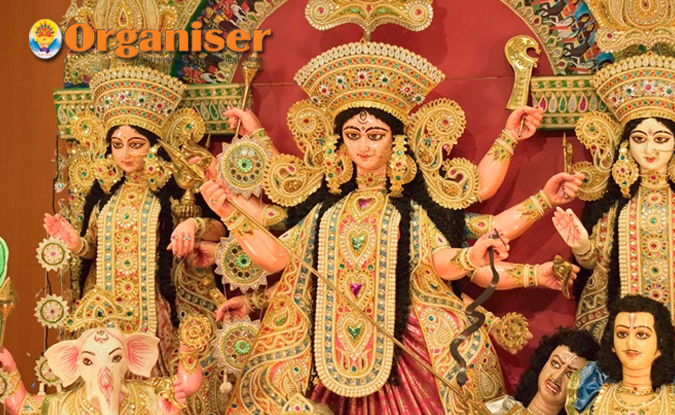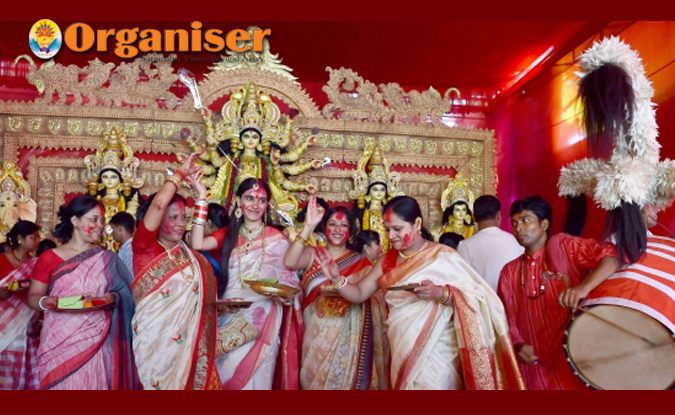Worship of Goddess has multiple dimensions in Bharat, and therefore, we have many Navaratris. Let’s understand that what explains the multiple celebrations in different seasons
-CL Gadoo
The word Navaratri originates from Sanskrit, Ratri means, Night and Nava mean, Nine. Sharada Navaratri is considered very sacred, auspicious when all the Divine forces are at their highest level of percipience.

Maa Durga
During Navaratri, the Divine Mother Goddess is worshipped in Her various forms as Durga, Lakshmi and Saraswati. Though the Goddess is one, She is represented and worshipped in three different essential aspects. On the first three nights of the festival, Durga is worshipped. On the following three nights, Divine Mother is worshipped as Lakshmi and then as Saraswati Devi on the last three nights. The Goddess Durga is Durgati Naashini: “One who destroys evil tendencies and evil forces”. Thus renders, peace, success & prosperity. Goddess Sri Mahalakshmi not only represents material but spiritual wealth. Both are like two sides of a coin and one cannot remain without the other. Therefore Goddess Lakshmi is symbolic of both Spiritual wealth and material wealth with success comes or follows the former. For spiritual wealth, one must gain knowledge.
For that, we have first to purify our minds. Only a pure and concentrated mind can attain knowledge, which is true wealth and this is obtained through the worship of Goddess Lakshmi Devi. Knowledge is power. Victory over the mind, senses & body (sense organs) can be gained only through knowledge. It is Goddess Saraswati who represents this highest knowledge of the Self. She is the very embodiment of the Knowledge itself.

Devotees celebrate Sindur Khela at Arambagh Puja Pandal during Durga puja in New Delhi
Purify the mind and remove all negativities; cultivate positive virtues; gain spiritual knowledge and transcend limitations. During Navaratri, Goddess Durga is invoked first to remove impurities from the mind. The Goddess Lakshmi is invoked to cultivate the noble values and qualities. Finally, Saraswati is invoked for gaining the highest knowledge of the Self. These nine days are an opportunity to be completely in Sadhana, Seva, and Satsang. It is the significance of the three sets of three nights when all these three are gained subjectively, and then there will be Vijayadashami, the day of true victory!
Five Times Celebration
Navaratri is celebrated five times a year. They are Vasanta Navaratri, Ashadha Navaratri, the Sharada Navaratri, the Paush Navaratri and Magha Navaratri. Of these, the Sharada Navaratri of the month of Puratashi and the Vasanta Navaratri of the Vasanta kala are important.
Basanta Navaratri: Basanta Navaratri, also known as Vasant Navaratri, is the festival of nine days dedicated to the nine forms of Shakti (Mother Goddess) in the spring season (March–April). It is also known as Chaitra Navaratri. The nine days of the festival is also known as Rama Navaratri.
Gupt Navaratri: Gupt Navaratri, also referred as Ashadha or Gayatri or Shakambhari Navaratri, is nine days dedicated to the nine forms of Shakti (Mother Goddess) in the month of Ashadha (June–July). Gupt Navaratri is observed during the Ashadha Shukla Paksha (waxing of moon).
Sharada Navaratri: This is the most important of the Navaratris. It is simply called Maha Navaratri (the Great Navratri) and is celebrated in the month of Ashvina. Also known as Sharada Navaratri, as it is celebrated during Sharada (beginning of winter, September–October).
Paush Navaratri: Paush Navaratri is nine days dedicated to the nine forms of Shakti (Mother Goddess) in the month of Paush (December–January). Paush Navaratri is observed during the Paush Shukla Paksha (waxing phase of moon).
Magha Navaratri: Magha Navaratri, also referred to as Gupt Navaratri, is nine days dedicated to the nine forms of Shakti (Mother Goddess) in the month of Magha (January–February). Magha Navaratri is observed during the Magha Shukla Paksha (waxing phase of moon).
But popularly Navratri is celebrated twice a year. First Navratra is from Pratipada of Chaitra month to Navami and the second is exactly after six months in Pratipada of Ashwin Shukla Paksha to a day before Vijayadashami. In the two Navratras, Sharada Navratra is given more importance. The celebrations begin on the first day of the month of Ashvin (i.e. Ashwin Shukla Paksha Pratipada) according to the Hindu calendar.













Comments